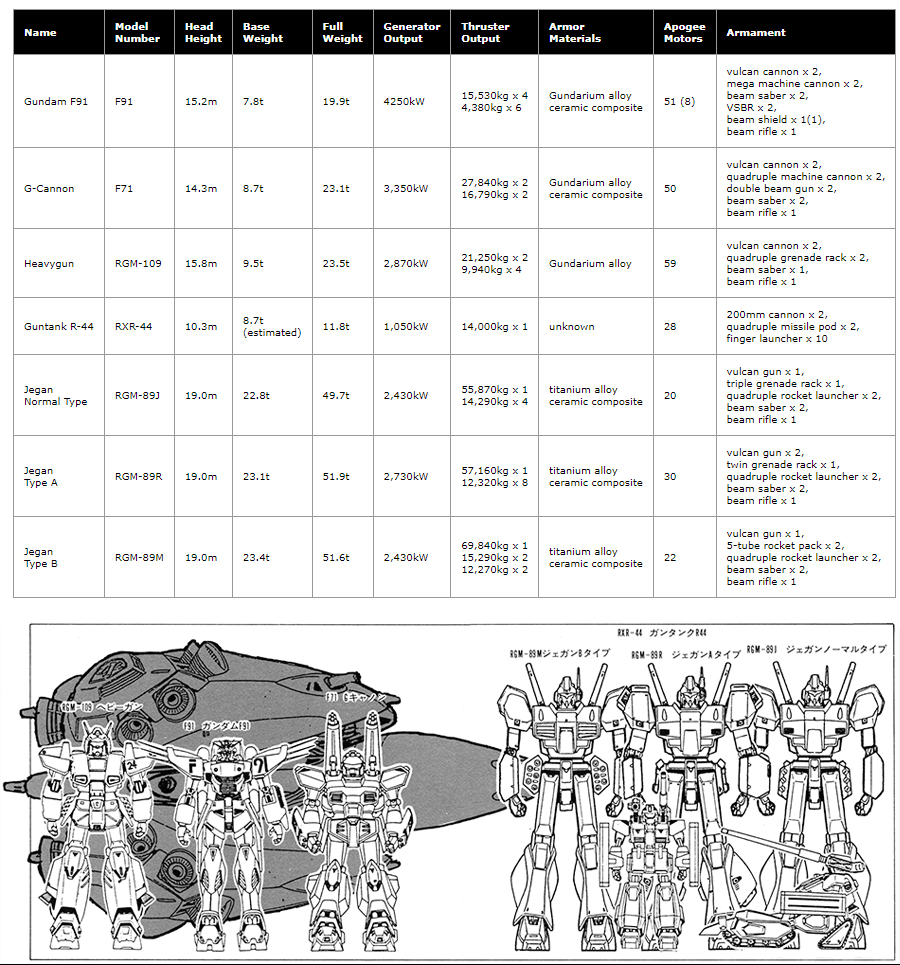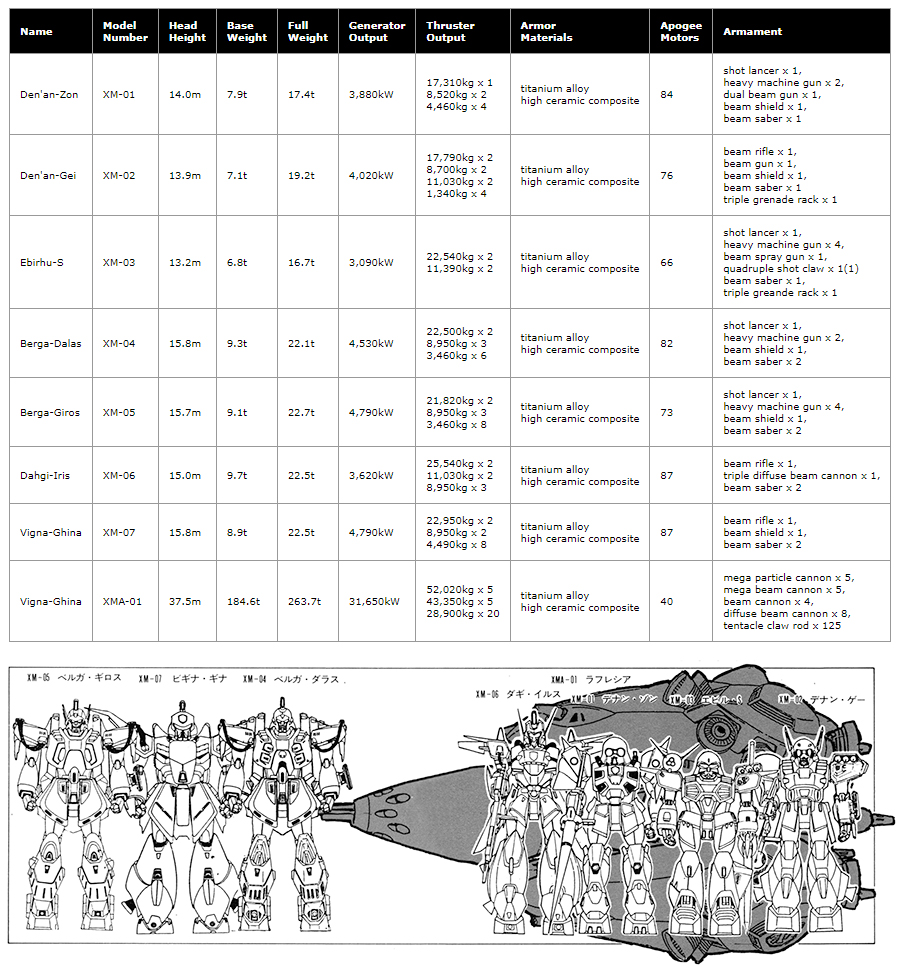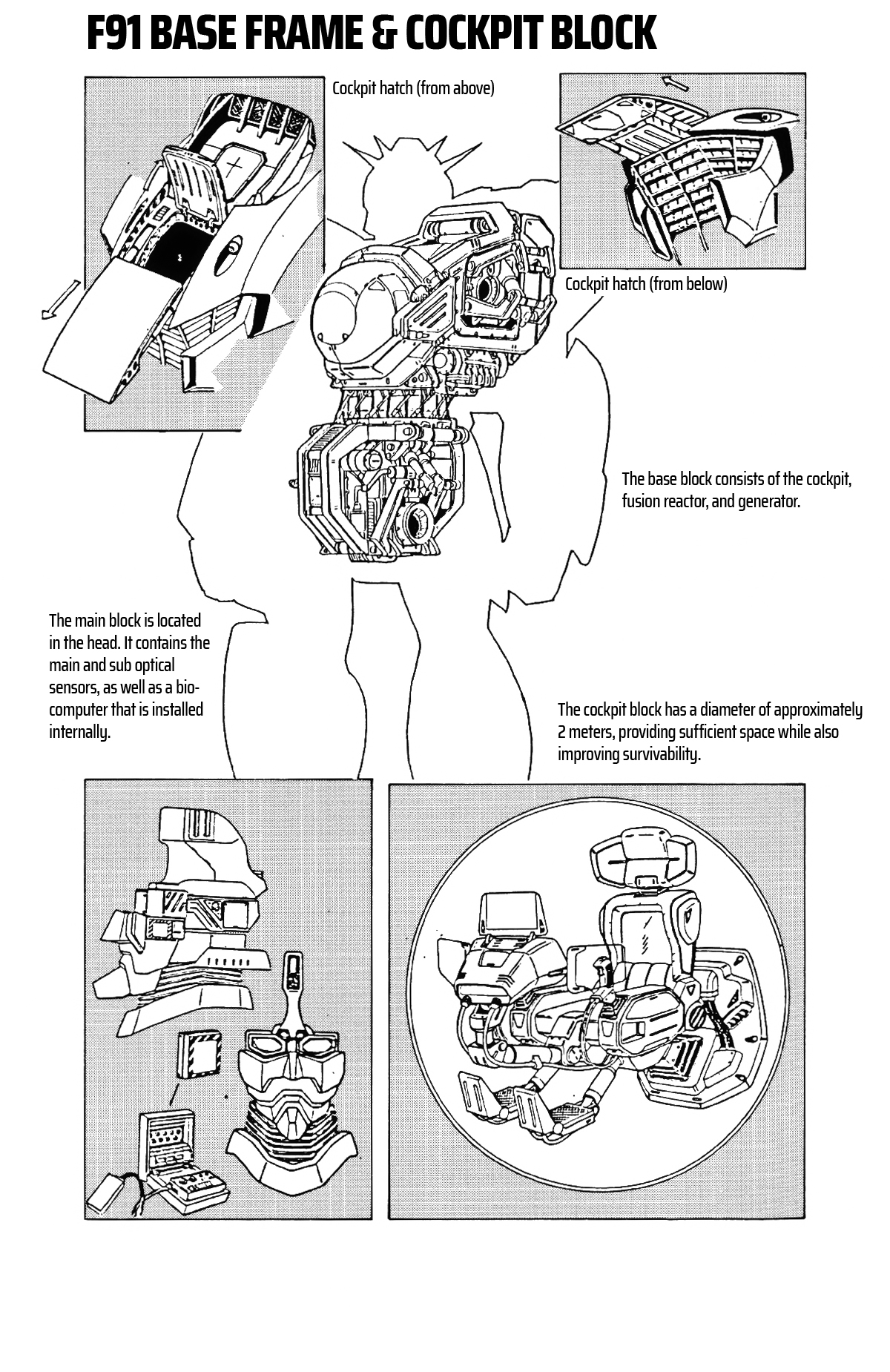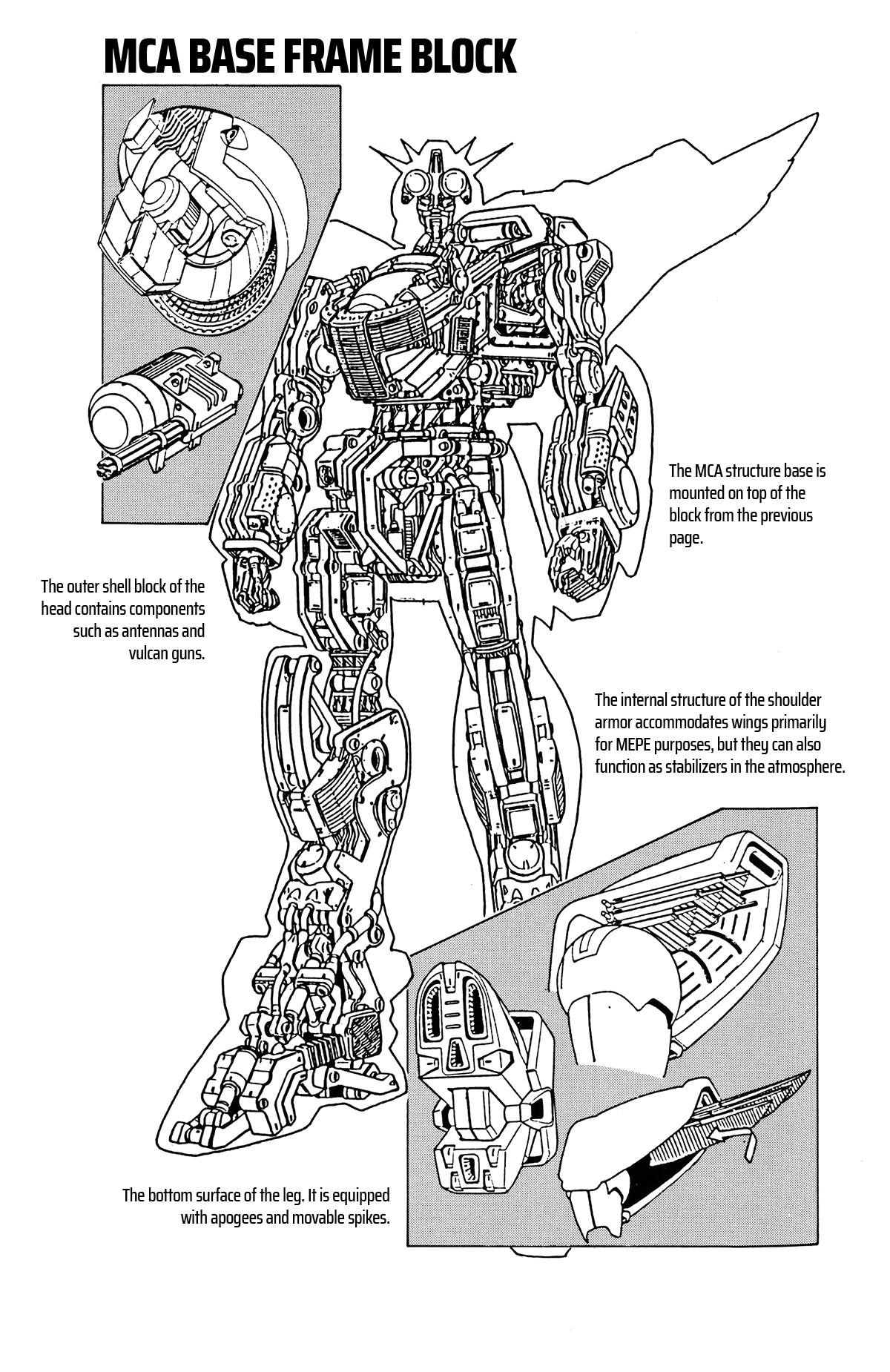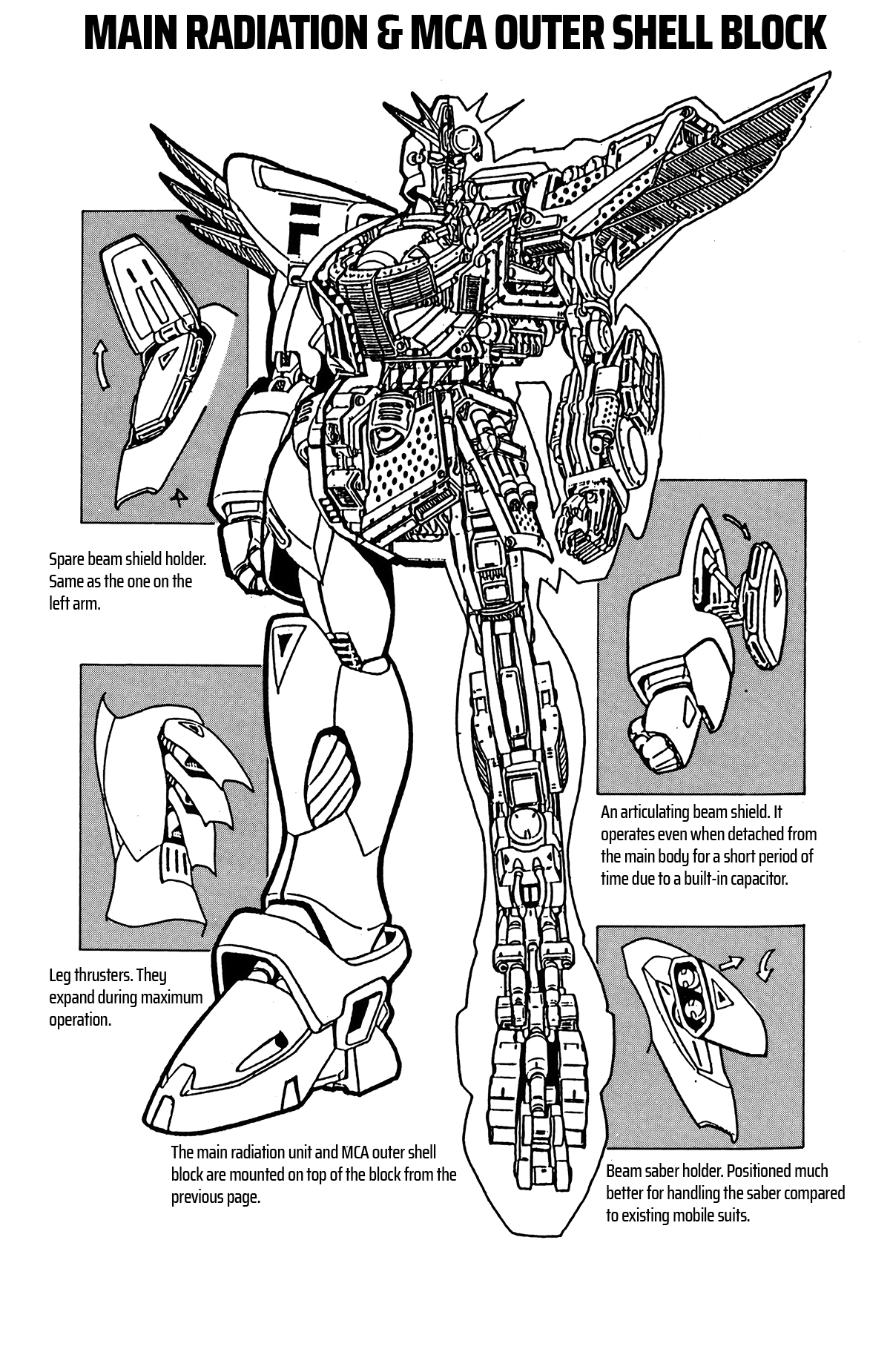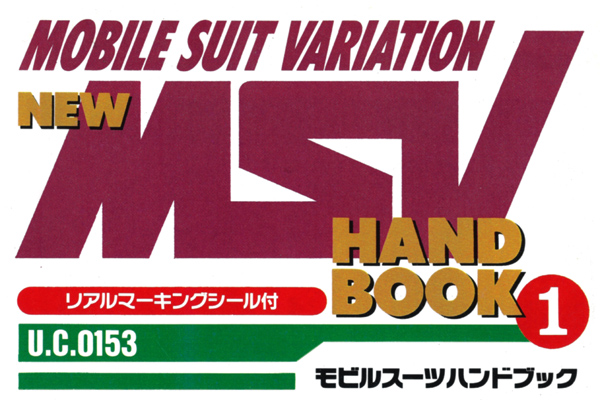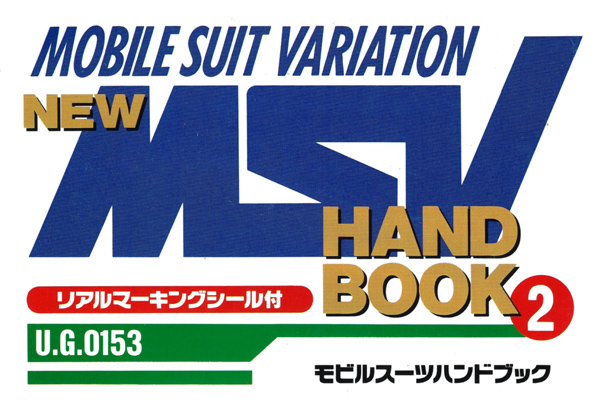Entertainment Bible 35
GUNDAM WAR HISTORY CHAPTER 5: COSMO BABYLONIA FOUNDATION WAR

1. Founding of a Nation for Ideals: Cosmo Babylonia
By the time the Universal Century had crossed its first century, humanity had accepted outer space as a normal part of their living sphere. The memory of the nightmare-like One Year War, which once brought half of humanity to death, was beginning to fade from people’s minds. Following Char’s Rebellion in UC 0093 and the Mafty Uprising in 0105, anti-Earth Federation activities also quieted down, and at first glance, the Earth Sphere seemed peaceful. However, on the contrary, the Earth Federation government was complacent with the surface-level peace, and the corruption within the government was further progressing. The Federation’s senior officials were pushing to redevelop the war-torn Earth, with the eventual goal of returning to the planet.
However, this was for the enrichment of their own lives and was far from the true regeneration of Earth. Meitzer Ronah, born in the middle of the Universal Century, expanded the Buffo Concern left by his father and worked towards realizing the ideal hidden in his heart. That ideal was cosmo aristocracy, the belief that in order to truly allow humanity to survive, those with abilities must take control. Meitzer brought together exceptional individuals into an organization called the Crossbone Vanguard as the vanguard to realize his ideal. And thus, he conceived the idea of rising up to establish the ideal kingdom, Cosmo Babylonia.
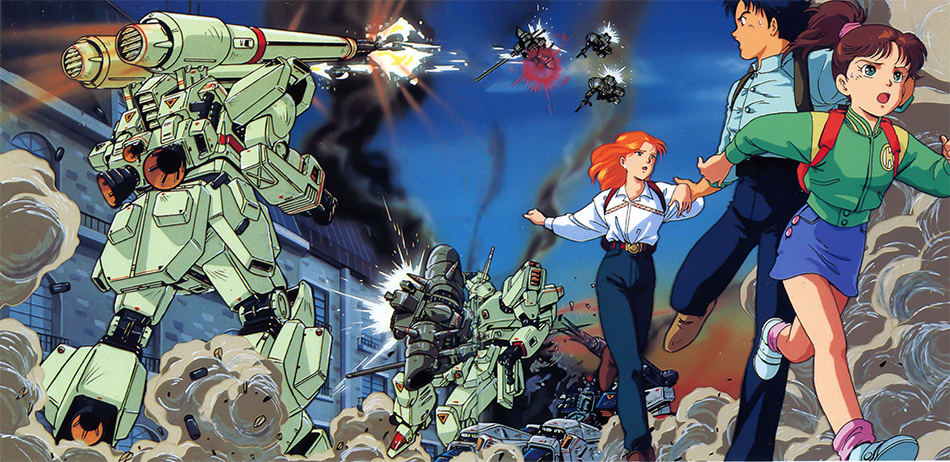
2. The Beginning of an Invasion: Frontier IV
The construction of new space colonies, known as the Frontier Side, had begun at the Lagrange point between the Earth and the Moon. One day, a mysterious military force suddenly invaded Frontier IV, one of these colonies. This army, wielding high-performance mobile suits, was none other than the Crossbone Vanguard. They had designated the Frontier Side as the territory for the founding of Cosmo Babylonia and began its subjugation. The Federation’s garrison, drunk on peace and distanced from warfare, was no match for the Crossbone Vanguard. Some even did not hesitate to use civilians as shields. The battle progressed one-sidedly.
High school student Seabook Arno encountered this event in the middle of a school festival. Seabook, with his friends, including his sister Reese and his schoolmate Cecily Fairchild, sought to avoid the battle and evacuate. They decided to use a space boat to go to another colony.
During their preparations, Cecily was about to be taken away by a Crossbone mobile suit. In trying to stop her, Seabook was wounded by a bullet from Cecily’s stepfather, Theo. Cecily went to the Crossbone with Theo, and Seabook somehow managed to escape from Frontier IV. Soon, the two of them would inevitably become involved in the battle.
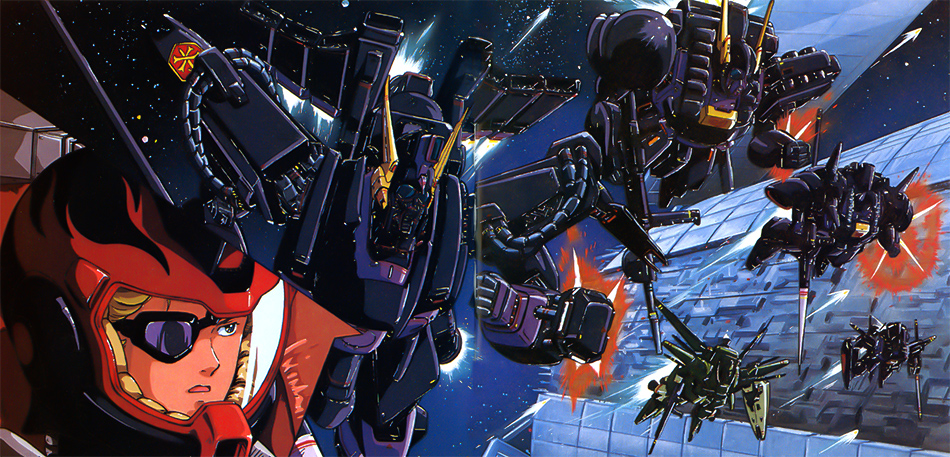
3. Subjugation, And Then…: Crossbone Vanguard
Having successfully suppressed Frontier IV, the Crossbone Vanguard used it as a base to begin their campaign of suppressing other colonies. They easily conquered Frontiers II and III, but they were struggling to attack Frontier I, where the headquarters of the Federation’s research institution, the Strategic Naval Research Institute (SNRI), was located. The attitudes of the residents of the Frontier Side were divided into two. One faction resisted the Crossbone Vanguard as brutal invaders, and the other faction sympathized with the ideology of Cosmo Babylonia and accepted it.
Frontier I had become a stronghold for the surviving garrison and the resistance. Seabook and his companions, who had fled to Frontier I, were asked to help with the battle due to the lack of fighters. Seabook, in particular, was made to pilot the new model mobile suit, the F91, which his mother Monica had participated in designing. In his first battle, Seabook achieved notable results, leading to speculation that he might be a Newtype.
On the other hand, Cecily, who had returned to the Ronah family as Berah Ronah, was placed in the Crossbone Vanguard’s symbolic position as the Berga Giros’ pilot and an idol. The Crossbone Vanguard, planning for complete control of the Frontier Side, launched a major invasion against Frontier I. Seabook and Cecily ended up reuniting as enemies on the battlefield, regardless of their own intentions.
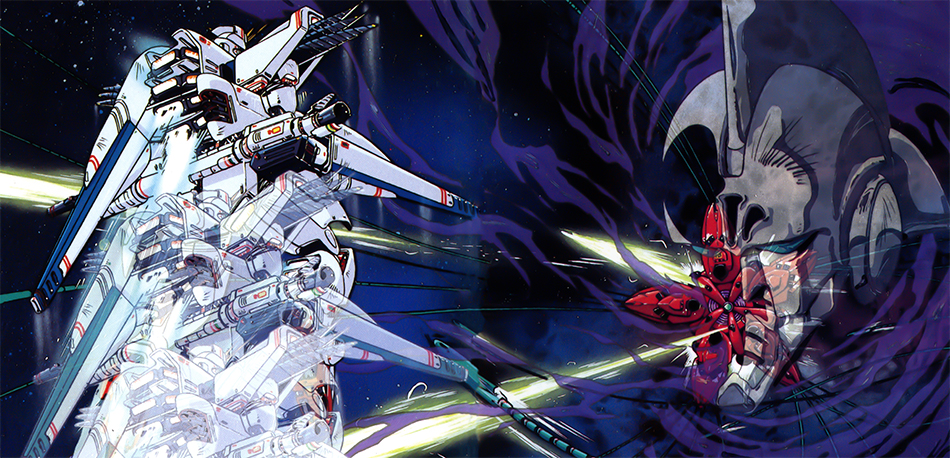
4. The Mad Mask: Laffresia
Cecily, convinced by Seabook, surrenders to the Federation Forces with her mobile suit. The Crossbone mobile suits that had invaded Frontier I were repelled, and it seemed that the battle was coming to a pause. However, Iron Mask, the supreme leader of the Crossbone, was activating an even more terrifying operation. From a battleship docked at Frontier I’s power generation facility, indiscriminate killing weapons, Bugs, were scattered throughout Frontier I. The Bugs would not cease their rampage until they slaughtered all the colony’s humans. To exterminate the Bugs, Seabook, and the others sortie, but they discover the Bugs also attack mobile suits. Moreover, being outnumbered, the Federation’s mobile suits are shot down one after another.
Seabook and Cecily headed for the docked battleship to cut off the main source. Cecily’s strike destroyed the battleship. Sensing a disruption in his operation, Iron Mask boarded his own mobile armor, the Laffresia, and entered the battlefield. The Laffresia’s attack power, which acted as the will of Iron Mask, surpassed even that of a battleship. Sensing the malevolent will behind the battle from Iron Mask, Seabook and Cecily bravely confronted the mobile armor. Iron Mask was unwilling to spare anyone who stood in his way, even trying to kill Cecily, his own daughter. Finally, Cecily was thrown out into space from her malfunctioning machine. At that moment, the Gundam roars to life in response to Seabook’s fighting spirit.
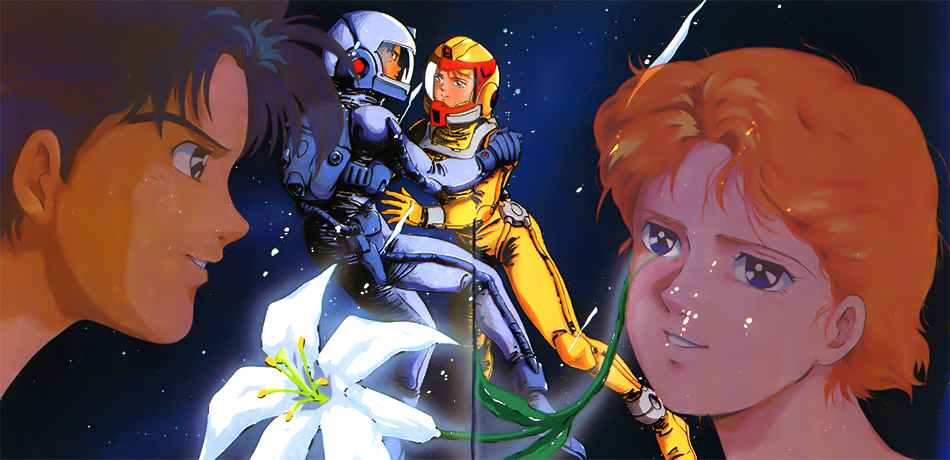
5. Searching for Home: Opening
Responding to Seabook’s fighting spirit, the Gundam went into full operation. The Laffresia, distracted by the shadows with mass, is sunk.
Recovering from a brief moment of disorientation after the explosion, Seabook desperately searched for Cecily. However, with the Gundam’s sensors partially damaged, he cannot locate her. He becomes distraught, but his mother, Monica, chastises him. She said that if he expands his consciousness, he should be able to find the soul that truly needed him. Sensing something, Seabook soared into space with only his normal suit.
The white light Seabook found turns out to be a lily flower. And beyond that was the figure of Cecily, lost in space, with nowhere to return, drifting alone. Catching up to Cecily, Seabook gently embraced her. Cecily’s eyes slowly open, and their gazes meet. They both become convinced that they are what each other needs.
Meanwhile, the Space Ark approaches to retrieve them.
Now, one battle has ended. But this is just the beginning of a new story.
Far in the distance, against the backdrop of the moon, the mobile suit forces of the Crossbone Vanguard that repelled the Federation’s reinforcements are gathering, preparing for their next move.
The section following the opening descriptions contains color mobile suit and character lineart, and mini descriptions, which have been omitted.
The mobile suits that were born in the U.C.0070s subsequently evolved and diversified, giving rise to numerous variations and becoming an unshakeable presence in the Universal Century. And then, around the time of U.C.0100, mobile suits experienced a dramatic transitional period.
![]()
Half a century had already passed since the birth of mobile suits. From the very beginning of their development, mobile suits have existed as weapons, and their purpose hasn’t changed much even to this day. However, their functions have greatly expanded, making them indispensable for military operations. Mobile suits took the place of mainstay weapons not long after their development, and they have remained as such for half a century. To achieve this, the addition of more and more functions led to a trend of upsizing the suits. This, in turn, required gradual updates to peripheral equipment, which led to an increase in personnel required for operation and maintenance and a rise in the operational cost of mobile suits. In addition, mass production often required large-scale facilities, and the manufacturing of mobile suits was entrusted to massive military-industrial complexes, resulting in a kind of monopoly, with major players like Anaheim Electronics dominating the industry.
With the declaration of the end of conflicts by the Earth Federation government, symbolized by Side 3, which had borne the name of Zeon, relinquishing its autonomy in U.C.0100. During this period, new mobile suit development and production were largely halted, except for a few cases, and there was a trend to reduce military spending. Of course, due to the pressure of the defense industry, mobile suit production lines were never completely shut down, but the development of new models was stagnating. The lack of large-scale battles during this period also accelerated this situation.
The soaring operational costs of mobile suits were mainly due to the expansion of operating facilities being recorded in the annual budget. Furthermore, in the Federation Forces, there was a bad habit of officers arbitrarily continuing to update equipment and facilities that were not urgently needed to avoid having their acquired budget cut. Nevertheless, during peacetime, the organization known as the Federation Forces had become an organization that only consumed personnel expenses and pensions. It had taken on a more pronounced role as a job creation agency, as previously pointed out. From past experience, it was impossible for the Federation government to completely eliminate military power. However, the Federation military found itself needing to demonstrate cost-cutting measures to the government.
This is the general background that led to the miniaturization of mobile suits.
Post U.C.0090, the only mass-produced mobile suit that continued to be developed was the RGM-89 Jegan, which remained the mainstay mobile suit of the Federation Forces for nearly three decades. This was partly due to the fact that the basic performance of this unit had reached a certain level, but the main reason was the enormous cost required for new developments. The Jegan underwent frequent minor changes and could supply mobile suit units to various locations for the time being. Yet, improvements to this model, using it as a foundation, were teetering dangerously close to their limits. Regardless of the absence of tangible threats, preparing for unforeseen contingencies was an impossibility under such constraints. This led to internal discussions within the military, and a decision was made to pursue both the supply of improved Jegan models and the simultaneous development of a new mobile suit.
The very genuine intention of cost reduction was an impetus for the miniaturization of mobile suits. This notion was not only financially prudent but had also been anticipated on the purely technical front within mobile suit development. Engineers in research institutions not bound by the Federation military had long advocated for downsizing mobile suits. The vicious cycle of expanding units to boost their capabilities was a well-understood reality, and the need for a paradigm shift had long been confirmed among these technical experts.
As the military policy for promoting the downsizing of mobile suits was established, the technicians under the Federation’s umbrella were finally given a chance to conduct research towards actualizing this objective. Different proposals were made regarding methods for downsizing mobile suits and modifying middle-range ones to withstand actual combat. Units such as the Guntank R44 were classified under the latter category, amalgamating the concept of transformable mobile suits and incorporating design elements from the G-Bull, a support device envisioned for the RX-78. However, during this period, the concept of small-sized mobile suits was still fluid. In the case of this particular unit, it was about half the size of existing mobile suits, utilizing thrusters salvaged from the Geara Doga, with capabilities limited to mere mobility. Conversely, it became clear that it was impossible to maintain performance while downsizing mobile suits without condensing the functions of the units. This led to its exclusion from the regular development plans. The subsequent development resulted in the RGM-109 Heavygun. This unit prioritized downsizing, and various avionics were simply downsized versions of those used in the Jegan and Gundam. While it fell short of the initially targeted high-performance machine, it confirmed the merits of downsizing. Moreover, its overall evaluation even surpassed that of the Jegan, leading to its mass production as a bridging unit until the next generation. These developments of smaller units served as a catalyst, leading to movements within the Federation military to rectify the monopolistic production system of mobile suit by Anaheim Electronics.
![]()
The underlying principle for developing the next generation of mainstay mobile suits was to create a “smaller, easier-to-procure mobile suit without any compromise in performance.” This task would have been impossible in the past, but now, with technical support, it has been put into action. Though there was no lack of opposition to the change of standard specifications underlying mobile suits, opinions existed within the government that the situation of Anaheim-led new weapon development had to be rectified. As a result, a movement to comprehensively review weapons acquisition in the Federation Forces emerged, enabling independent research in Federation-affiliated research institutions, starting with SNRI.
The term “Formula” was the project name used internally within the military, and externally it was portrayed as a hypothetical plan to serve as a check against Anaheim. However, due to poor management of the Federation’s classified information, leaks occurred, and as a result, a competition was hastily conducted to select the next-generation main mobile suit.
In the end, as intended by the Federation, the mobile suit from the Formula Project was developed as the next mainstay mobile suit. However, with its proven track record, Anaheim could not be excluded from the weapon supply, and the issue was resolved by outsourcing the production of the F70, the mass-production model of the F90 S-Type, to Anaheim. The F71 G-Cannon was produced this way, designed by SNRI, but manufactured by Anaheim. As a result, parts such as the generator and thrusters were off-the-shelf products from Anaheim, and performance equivalent to the F70 couldn’t be achieved due to compatibility issues. However, it achieved performance that surpassed previous mobile suits, including the thrust-to-weight ratio, and it sufficiently met the criteria for a small, high-performance mobile suit.
Various trials and errors were repeated in anticipation of the miniaturization, and a plan to reconsider the basic structure of the mobile suit itself was also proposed. This was the MCA (Multiple Construction Armor) structure, which was neither a movable frame nor a monocoque. Previous mobile suits housed various electrical equipment, moving parts, propellants, etc., between the structural materials and the armor. In particular, the complexity of the TMS structure caused difficulties in maintenance. Therefore, the idea of simulating the miniaturization of the mobile suit and transforming the structure itself was born. Each block constituting the unit would serve as both a structural material and armor, allowing for the overall weight reduction of the mobile suit itself. In addition, it had been pointed out that as mobility improved, a smaller and more maneuverable mobile suit would have a lower probability of being hit. However, achieving practical effectiveness in combat scenarios had not been possible. Nonetheless, adopting the MCA structure made it possible to design a high-mobility mobile suit that could withstand real combat. This was embodied in the F91.
![]()
The Crossbone Vanguard had achieved the miniaturization of mobile suits ahead of the Federation. This was because they could disregard cost-effectiveness and develop high-performance machines. What made this possible was that the Crossbone Vanguard was a young organization, and its parent organization, the Buffo Concern, had incorporated companies capable of everything from junk collection to the manufacturing of aerospace vehicles. While not a widely recognized company in general, they possessed all the technology necessary for manufacturing mobile suits. For the Crossbone Vanguard, the miniaturization of mobile suits was a top priority. The performance enhancement of suits and their size were not necessarily proportional. Conversely, it was clear that improved response could lead to performance far exceeding existing suits, considering cost-effectiveness. The Crossbone Vanguard was one of the few organizations that could make this possible at the time.
At a time when the Federation Forces were deliberating an improved model of the Jegan type, the Crossbone Vanguard had completed the manufacturing of a small, prototype mobile suit, the Dessa-type. Notably, they had recognized early on the effectiveness of smaller mobile suits, including in the procurement of warships.

The test results of the Dessa-type, which had its generator placed outside the suit with total thrust distributed throughout the various parts of the unit, showed excellent performance. Based on this mobile suit, the Den’an-Zon, a general-purpose close-combat mass-produced unit, and the Berga-Dalas, a close-combat unit for commanders, were produced by selecting the necessary functions for each. In the Crossbone Vanguard, mobile suits were not developed and applied to operations but were developed according to strategic needs. While using each completed suit as a base, the Den’an-Gei, a general-purpose combat type, was developed from the Den’an-Zon, and the Ebirhu-S was designed for reconnaissance purposes. Additionally, the combat and close-combat mobile suits developed by the Crossbone Vanguard were equipped with shot lancers, considering combat within colonies. These shot lancers are designed not to destroy the fusion reactors of enemy mobile suits. The lance tip is ejected using the same principle as a linear gun and can penetrate even Gundarium alloy armor.
Furthermore, the tip can be divided into four blocks and fired as needed. In addition, the generator had extra capacity due to miniaturization, allowing for the deployment of a beam shield that seamlessly combines offense and defense. This equipment operates on the same principle as a beam saber and can defend against both physical projectiles and beam weapons, as well as serve as a weapon itself. Its greatest advantage is that it can be deployed as needed without becoming dead weight or damaging the unit. This enables the full utilization of the unit’s mobility. This equipment was made possible thanks to the development of a high-performance generator. Their flexible approach to mobile suit development afforded steady results once a policy was established.
Incidentally, the Crossbone Vanguard did not necessarily keep the development of small, high-performance mobile suits completely top secret. The development of the Den’an-type mobile suit was actually introduced in specialized civilian magazines and the like. Well-informed insiders even published speculations suggesting that the miniaturization of mobile suits achieved through technologies such as Buffo Aerodynamics and others was driven by certain motives. However, it cannot be denied that these pieces of information may have been deliberately leaked disinformation from the Crossbone Vanguard side. They maintained strict control over information and established simulations in the event of any inconvenient intel leaks.
![]()
The Berga-Dalas is equipped with shelf nozzles to ensure mobility surpassing that of the Denan-type, distinguishing it from the general mass-produced units. Additionally, the Berga-Giros is equipped with further enhanced shelf nozzles and features a detachable shot lancer to improve the versatility of its manipulators. The apogee motors equipped across the suit also contribute to its mobility.
Shelf nozzles are movable thrusters developed by the Crossbone Vanguard that further evolved the concept of externally mounting the generator. It combines the functions of the AMBAC system, which uses the mass of the unit itself, and the vernier binders. This concept was inherited by the Vigna-Ghina and further improved, resulting in the adoption of the fin nozzle. Due to its structure, the fin nozzle has a direct connection to the generator, minimizing energy transmission losses and enabling even more efficient operation. The Dahgi-Iris, a derivative unit based on the Berga-Dalas, is a commander-type reconnaissance mobile suit equipped with electronic equipment. It has about five to six times the information processing capacity of a regular mobile suit and can integrate data collected by teams consisting of units such as the Ebirhu-S. Furthermore, it does not have a beam shield that interferes with precision sensors and electronic equipment, allowing it to allocate all of the surplus energy from the generator to achieve thrust surpassing that of the Vigna-Ghina. It is also equipped with a newly developed doppler radar, enabling accurate enemy detection even while the unit is in motion.
The Bug and Laffresia are systems devised independently by Iron Mask, the commander of the Crossbone Vanguard. The Bug is an anti-personnel, human-targeting weapon designed to eliminate only humans without causing excessive damage to facilities such as colonies. It utilizes heat detection, carbon dioxide reaction, motion sensors, and other means to achieve its purpose. The Parent Bug unit is equipped with 24 large chainsaws and can levitate and rotate using Minovsky Craft and verniers, allowing it to slaughter humans along with vehicles, buildings, and facilities. For those that are inaccessible to the parent unit, such as those in shelters, the Parent Bug is divided in half, releasing units called a Child Bug, which carry out the complete annihilation of humans using eight blades and explosive actions.
The Laffresia, on the other hand, is the culmination of Carozzo’s ongoing research in equipment manipulation and the study of will perception prior to his involvement with the Crossbone Vanguard, incorporating a system that could be called neo-psycommu. It is a mobile armor operated entirely by the pilot’s thoughts. It is equipped with tentacle rods, each carrying 25 chainsaws and independent verniers, in five units, as well as numerous laser cannons.
After U.C.0100, mobile suits underwent improvements in performance and significant changes in their external appearance. This was particularly evident with the introduction of the Crossbone Vanguard, which brought about a more distinct evolution. Let’s take a look at the specifications of the latest mobile suits.
![]()
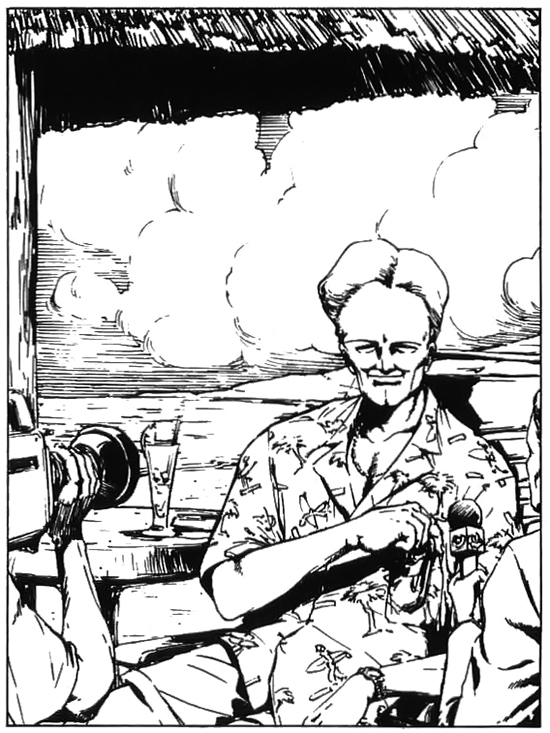
Despite the dire situation at hand, a high-ranking official of the Federation government comfortably enjoys himself at a resort destination.
![]()
Since “Char’s Rebellion” in U.C.0093, there hadn’t been any major dust-ups involving large-scale military actions. The Federation government believed that the turmoil in the Earth Sphere had been eradicated. Various organizations and movements emerged and disappeared, claiming to advocate for the desires of Spacenoids, but they never had a significant influence on the masses. Humanity continued to waste time and resources in a force of habit, even though the majority of people lived in space, causing exhaustion to the Earth. The bureaucrats and politicians of the Federation government no longer questioned what kind of era the Universal Century was.
In the year U.C.0123, when the Frontier Side was attacked, the Federation government didn’t issue any instructions to the stationed troops. They underestimated the attack by the Crossbone Vanguard, considering it merely a conflict among space migrants and the rebellion of anti-Earth Federation organizations at best. The Federation soldiers stationed in the colonies had to make their own decisions and take action. The stationed forces, disregarding the well-being of the inhabitants, engaged in indiscriminate shooting and naval bombardment from outside the colony walls without hesitation. However, the regular forces were swiftly wiped out, leaving only citizen guerrillas and new recruits. Reinforcements were dispatched from places like the lunar base as an excuse, but the Crossbone Vanguard annihilated them.

The Crossbone Vanguard’s small-scale mobile suits have performance that far surpasses those of the Federation.
![]()
The Crossbone Vanguard (C.V) is a combat group led by Meitzer Ronah, with Iron Mask acting as supreme commander. This organization has a political and social aspect and aims to correct the corruption of the Federation government and the degeneration of the general public.
Half a century after the start of the Universal Century, the Buffo Concern, which would become the basis of the Crossbone Vanguard, was founded by Meitzer’s father, Scharnhorst Buffo. Subsequently, the business of the Buffo Concern expanded due to the collection, regeneration, and recycling of the remnants of ships, mobile suits, colonies, and other debris, born out of many subsequent wars. If that was all, it might not have been different from so-called war merchants such as Bergamino and Stampa Haloi, but Buffo was different. He had a principled policy and was pure in everything. He talked about his ideals to his sons. Influenced by this, Meitzer was able to gain a comprehensive perspective of the Universal Century. Meitzer fully understood the significance of his father’s purchase of the name of the Ronah family, an old European noble family from the old century, and he carried on that legacy. Then he steadily prepared and arranged for the realization of that dream, patiently waiting for the opportune moment.
The year was Universal Century 0123. The time had come.
![]()
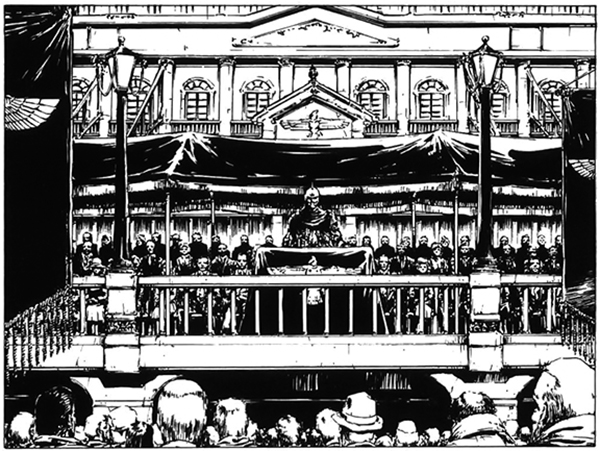
The declaration of the Cosmo Babylon by the Crossbone Vanguard in front of the Frontier IV Government Building.
Cosmo Babylonia is the name of the nation that represents the way humanity should be in the Universal Century, as envisioned by the Crossbone Vanguard. With the Ronah family, including Meitzer, at its core, it imposes on itself the task of serving as a model for the people and has made it a national policy to transform social issues and structures. They advocate cosmo aristocratism, which aims to realize a society guided by suitable individuals and to ensure the eternal survival of humanity as a whole, as the thousand-year dream of the Ronah family.
The Crossbone Vanguard made its appearance on the stages of history through the attack on Frontier IV. However, this was not something that happened suddenly but was also a grand plan that had been advanced since the time of its founder, Buffo. The Buffo Concern was ostensibly a regular corporation and had dealings with Anaheim Electronics. In addition, many of Meitzer’s relatives were excellent individuals who supported the Crossbone Vanguard directly and indirectly from the perspectives of politics, economics, and religion. It is not baseless to speculate that the Crossbone Vanguard’s attack on the Frontier Side was not accidental but was planned from the construction stage. The Crossbone Vanguard secured the cooperation of the Jupiter resource mining ship, the Thousandth Jupiter, declared Cosmo Babylonia in the Frontier Side they had conquered and raised a rebel flag against the Federation government. Iron Mask, who had unilaterally commanded random killings, was defeated, but the Crossbone Vanguard had achieved its initial objective. The Earth Sphere was once again entering an era of chaos.

![]()
In the Federation Forces, groundbreaking and high-performance mobile suits were often developed during times of large-scale military projects. The RX-78 Gundam was created for actual combat deployment during Operation V, and the Zeta Project within the AEUG was able to produce the MSZ-006 Zeta Gundam and MSZ-010 ZZ Gundam. Then, the RX-93 Nu Gundam was the culmination of all previous Gundam-type mobile suits. The F91 was a mobile suit born out of the “Formula Project,” a collaboration between the Federation Forces and SNRI.
During the U.C.0100s, the development of mobile suits in the Federation faced significant obstacles. At that time, the Federation forces had decided on the miniaturization of mobile suits in order to drastically review the efficiency required for their operation, including maintenance. However, unless the basic structure, which relies on technology supplied by Anaheim Electronics, was reviewed, it was impossible to miniaturize while maintaining performance. This was because the fundamental structure of Anaheim-made mobile suits did not allow for the isolation of the fusion reactor and generator, and they had to be integrated into the main body. This issue was pointed out by military engineers and brought under consideration. At the same time, largely for political reasons, it had been decided to promote mobile suit development under the leadership of the military, as it had been in the past. Therefore, the task of developing the new mobile suits was assigned to SNRI, which had not been involved in development until then.
SNRI, short for Strategic Naval Research Institute, primarily prototyped large-scale structures and mobile equipment for the Colony Public Corporation. Based on SNRI’s proposal, a design plan was implemented to externalize the generator. Essentially, it was a matter of changing the orientation from vertical to horizontal, but the routing of circuits and conductive devices proved to be more challenging than anticipated. Moreover, since it was not a simple scaling down of existing mobile suits, ensuring practical effectiveness was nearly impossible. However, with the invention of the MCA structure, it became possible to achieve an unprecedented level of high-density implementation.
![]()
A Multiple Construction Armor (MCA) structure is a concept that refers to multi-function armor. It was devised based on a concept different from conventional armor. Previously, multi-function armor referred to armor treated with a combination of features such as reactive armor, Chobham armor, and beam-resistant coating. It was a fusion of functions as armor, but MCA has the characteristic of combining functions other than armor.
Traditional mobile suits have a structure where necessary equipment for operation is attached around the movable frame and covered with armor. Normally, the armor of a mobile suit was developed with a focus mainly on ballistic resistance, stealth, etc. When considering the miniaturization of mobile suits, it became clear that with the existing structural concept, it would be necessary to make compromises, making it nearly impossible to achieve high performance. Initially, research has progressed in compacting components like nuclear fusion reactors and generators, but it has been concluded that it is impossible to miniaturize and enhance performance while using a monocoque or movable frame structure. The MCA was developed under such circumstances. MCA serves as both the structural material, the internal electronic equipment, and the armor itself.
Incorporating the functionality of electronic devices into the structural materials themselves had been demonstrated in systems like the psycho-frame equipped on the Nu Gundam. Computer chips at the LSI level can be embedded into the metal. By applying and developing this technology, it was possible to shape the system of the mobile suit itself. With MCA, allowing the structure to handle circuit routing and other tasks became possible. As a result, the unit weight could be drastically lightened, the thrust-to-weight ratio was improved, and it became possible to reduce the hit rate, including evasion through maneuverability. Of course, improving and establishing surrounding technologies such as small, high-performance, high-output generators is also a significant factor.
In the case of the F91, when looking at the internal components of the machine on a part-by-part basis, it appears not much different from previous frames and shock-absorbing materials, but in reality, these internal structures have various complex functions. These functions are demonstrated when they are assembled in block units at the design stage. Each block incorporates a fail-safe system that takes into account potential damages and failures, ensuring that a partial malfunction does not render the entire unit inoperable.
Overall, the F91 was able to acquire high mobility far beyond existing mobile suits. Furthermore, to integrate these functions, it was decided to incorporate a bio-computer, which is currently assumed to be the most effective technology available. This decision was based on the characteristics of the F91’s system, and it was judged that a bio-computer with a neural structure would be appropriate for implementation.
![]()
The F91 surpasses existing mobile suits with its exceptional maneuverability. Due to the surplus power in its generator, it’s capable of equipping things like the VSBR and a beam shield. However, this also results in a need for a limiter when used by regular pilots. The F91 is a high-performance machine that might not unleash its full potential unless piloted by what’s called a “Newtype.” Therefore, it needed a function to determine whether the pilot could cope with the maximum operation of the machine. This is the main reason for adopting a bio-computer made up of a biomatrix.
The bio-computer installed in the F91 was not originally intended for weapon deployment but was considered as a form of psycommu development to alleviate stress on the operator. If the ideal form in man-machine interfaces is a psycommu, then it’s a highly appealing challenge for researchers. If a method to solve the problems inherent in the psycommu system is established, it would enable the organic connection of memory and emotions. This can be said to be a universal issue for scientists and engineers in the field. In this sense, it’s not an exaggeration to say that it was made with the same concept as the neo-psycommu installed in the Crossbone Vanguard’s XMA-01 Laffresia. The bio-computer installed in the F91 is capable of not only controlling the machine but also synchronizing with various sensors.
Based on the judgment made by the bio-computer, it is determined and confirmed that the unit requires maximum operational capacity. When the mode is switched, the unit’s operating settings are changed, and cooling of various parts begins in order to maintain alignment throughout the excessive movements. This is primarily due to the bio-computer’s aversion to high heat. Especially in space, where heat dissipation is not as effective as in the Earth’s atmosphere, catalysts are added and dispersed in areas such as the head. For catalytic discharge, the face guard is stored in both cheeks, exposing the air ducts. Also, this results in the Metal Peel-off Effect (MEPE). This is a byproduct of the MCA structure, and its effect allows the armor itself, not just the radiator or catalysts, to dissipate heat. It functions like the so-called anti-beam coating, applying special surface treatment to the armor. MEPE leaves an afterimage with the contour of the machine and a certain mass in the direction of inertia. This afterimage, made primarily of metal particles, can deceive radar and other enemy search devices and the naked eye of the pilot. In this era, mobile suits and mobile armor are displayed on monitor screens using computer graphics, making it even more susceptible to illusions. The reason why the F91 appears to have clones during maximum operation is because of this.
MS GLOSSARY
This section is still being translated.
beam flag
beam lancer
beam shield
biocomputer
Black Vanguard
Crossbone Vanguard: A combat group organized by Meitzer Ronah. It gathers innovative, young people who fight using unique mobile suits. Despite being a small and elite group, their morale and combat power greatly surpass the Federation Forces, which is more than double their size.
double beam gun: Fixed firearms equipped on both arms of the G-Cannon. They are specifically designed for close combat when the cannons are removed.
fin nozzle
Formula
hybrid dual sensor
machine cannon
Multiple Construction Armor
Newtype: A concept thought of as human evolution during the One Year War. As the war escalated, they were seen as individuals who could efficiently handle weapons and were treated as tools. This led to the creation of artificial Newtypes, or Cyber-Newtype, resulting in numerous tragedies. By the year U.C.0123, the term had become almost obsolete, and it was mostly seen as a way to describe individuals with exceptional piloting abilities.
shelf nozzle: A concept born from the idea of attaching the generator outside the mobile suit to accommodate its downsizing. Each unit combines mobility as thrusters and maneuvering capability as an AMBAC system.
shot claw: A fixed armament on the left arm of the Ebihru-S. In addition to melee combat, it can also be used for throwing attacks.
shot lancer: A distinctive weapon equipped by Crossbone mobile suits. It has a silhouette that closely resembles a spear carried by medieval knights. When equipped, it emphasizes the knightly impression of the Crossbone’s suits.
SNRI: A military research institute based on Frontier I. It officially stands for Strategic Naval Research Institute. They have been working on the development of the military’s mainstay mobile suits since the F-series. They are currently developing the F91.
tentacle rod: The name for the numerous tentacles equipped on the Laffresia. The tips are equipped with a chainsaw and a beam cannon. They are quite powerful and can easily entangle and capture a mobile suit.
VSBR
wire gun
F91 SETTING MATERIAL COLLECTION
This section contains black and white mobile suit and character lineart, and mini descriptions, which have been omitted at this time.
The term used here is 触媒排出, or catalytic discharge.






